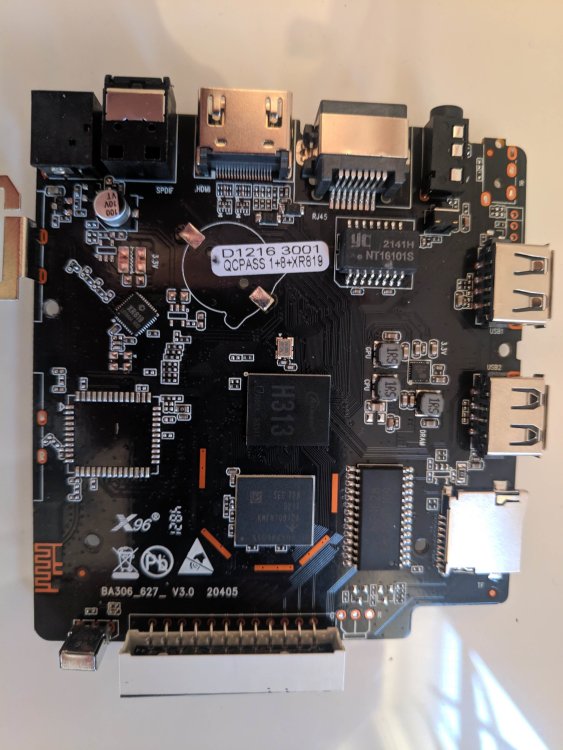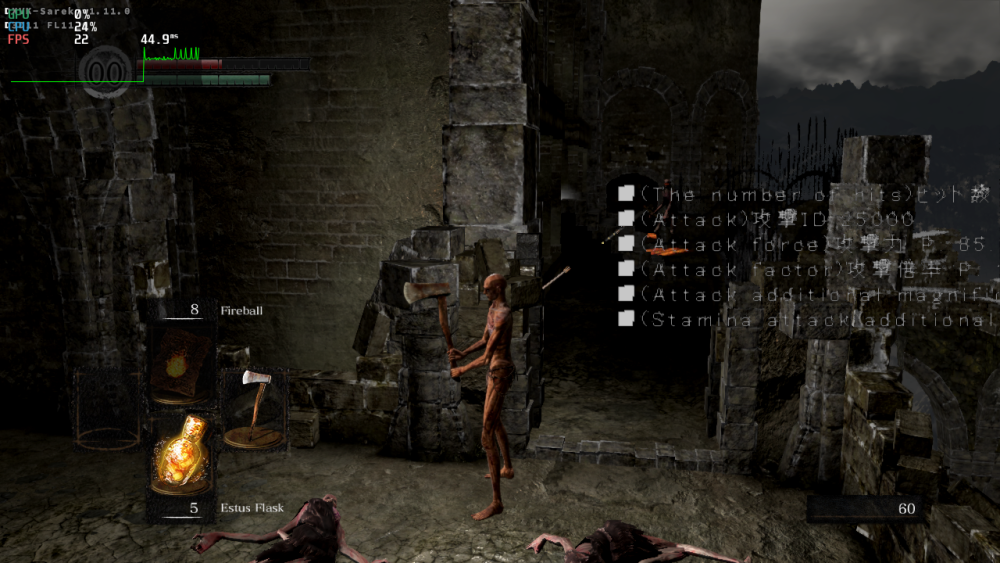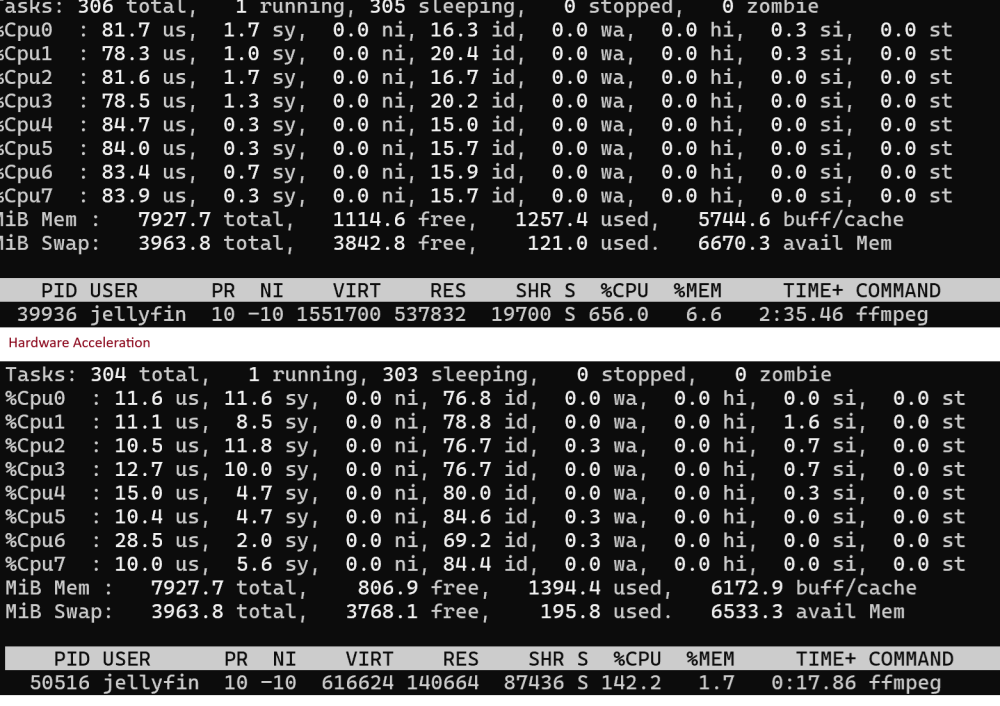Active threads
Showing topics posted in for the last 365 days.
- Today
-
@CyberHaZard Thanks for the feedback. Yes, the internal eMMC is untouched. You can mount these Android partitions in your file system if you want to access them. Thank you for the offer. I already have access to the Android OS, but tests are apriciated Usb3 is not fully implemented yet . It might just be a Linux configuration issue. I still need to investigate. Maybe it's also acting as a device. there could be a switch via GPIO. The front LED display uses the HT1628 chip. There's a driver available at https://github.com/venkatesh4009/TM1628_LED_Driver It's worth a try.
-
I believe you have managed to overcome the majour Espressobin culprits, i.e. frequency scaling resulting in instability. It was a deadlock for me in the kernel choice and uboot frequency build version. At some moment I was compelled flashing uboot with frequency downgraded to 1GHz and 800 MHz in order to get stable setup for production. Good catch! Your use of Arch Linux is also interesting. Which flavor have you installed ? Is it from https://archlinuxarm.org/platforms/armv8/marvell/espressobin ? I routinely out of curiosity try alternative builds for testing and comparison when making new setups despite that Armbian remains a preferred one so far with general score of usability.
-
Hey, I am really happy there is someone else with M1S - just got it today in the mail and after first boot received notification that ubuntu 20.04 server is no longer supported (shocker!). It would be nice to be able to run later kernel (you've mentioned 6.12) on the machine. I was not able to follow your steps to get it working, unfortunately. I don't care for desktop performance at all. Would it be possible to get the image of ubuntu noble server? Or is there some place with idiot-proof step-by-step guide for noobs? Thanks in advance!
-

Armbian Linux v6.1 - Bluetooth not working - no BT controller found
SM2027 replied to SM2027's topic in Banana Pi M7
A service was created to fix the issue, should be this added to official BPI-M7 image? sudo nano /etc/systemd/system/btattach.service sudo systemctl daemon-reload sudo systemctl enable btattach.service sudo systemctl status btattach.service sudo systemctl start btattach.service sudo systemctl status btattach.service cat /etc/systemd/system/btattach.service [Unit] Description=Bluetooth UART Attach Service After=network.target Before=bluetooth.service [Service] Type=simple ExecStartPre=/usr/sbin/modprobe bluetooth ExecStartPre=/usr/sbin/modprobe hci_uart ExecStart=/usr/bin/btattach -B /dev/ttyS6 -P bcm -S 115200 Restart=always [Install] WantedBy=multi-user.target -
@SteeMan thank you for the help! Well it is what it is, will look for the possible alternatives.
-
Hi, can you confirm that the OLED is working connecting it to another device (raspberry, Arduino)? It should be properly powered, cables should be checked if ok. Also, check in the spec if pull-up resistors are needed. You can force a scan of all i2c addresses again like this: # Force scan all addresses for i in {0..127}; do sudo i2cget -y 1 $i 2>/dev/null && echo "Device found at: 0x$(printf '%02x' $i)" done
- Yesterday
-
Getting video acceleration is realtively easy in bookworm, but making it work in Trixie would be newsworthy
-
Thanks for the reply! I bought used and had no luck at all getting things running (this was some time ago and things are hazy). Have you written up your experience anywhere I could look at? Sent from my iPhone using Tapatalk
-

Radxa-cubie-a5e second Ethernet port not work after update
Luca Gerber replied to Samixa's topic in Allwinner sunxi
Hi, if you compile your kernel with "CONFIG_SUN55I_PCK600" set, you'll have the second ethernet port. But you'll loose the wifi adapter, just like in the trunk.129. -

Help wanted to test a new OpenVFD alternative
Jean-Francois Lessard replied to Jean-Francois Lessard's topic in Amlogic meson
@Hqnicolas thanks for your feedback! It's appreciated! -
thank you for your work. i have the x96q pro picture attached. i have built the x96q lpddr3 and the w96q lpddr3 v1.3 . both are booting . the problem is with wifi sometimes is not recognised and it needs rebooting few times to work. also i noticed with lpddr3 build the cpu cores are always near 100% but with lpddr3 v1.3 only one core get 100% and not too often.
-
Hello, idk if this the right place to ask, but, I'm really struggling to get a working driver for the sv6256p, I can't find a repository that compiles on kernel 6.X. My question is, where is the driver source that builds for the rk322x uses? I want to compile it on my installation. I already tried moving the driver files from a rk322x build to my installation, but it didn't work.
-
I am in the process of installing Armbian on the X88pro13 TV box, which has the RK3528 CPU. https://github.com/joilg/x88pro wifi and ethernet are working
-
@GmP oook, so now I understand the differences between the two dtso files provided here and in the other thread. Do you spot other differences or peculiarities? Things that are useful are: * the gpio led (do the separate red/blue/green led blinks on both boards?) * wifi reset gpio (do wifi get detected in both boards with base configuration?) * is there a separate PMIC like rk805/rk808 on any of the boards? Things like these go into the dtso for full board support. The PMIC is very important since missing that could cause stability issues.
-

RK3588 - Setting Up Mali & Hardware Acceleration
Gian Luca replied to David N's topic in Orange Pi 5 Plus
I followed the "mesa route" without any kind of problem. I cannot following the "libMail route" due to my window manager choice: I installed the Armbian Ubuntu Noble version, but I'm running X Window (not Wayland) in order to get the remote display of the Orange PI Plus running on a local monitor; I tried to do this using Wayland without success. I'im running lightdm and xfce4 now. So the /dev/mail0 is still useful or the mesa-vulkan-drivers are enough ? I read some documentation about the hardware acceleration but in my opinion it is too contradictory. But it is always possible that I'haven't understand anything..... -
Even though current is an LTS kernel it probably makes more sense to focus on vendor an edge. vendor because its rockchip bsp and close to being feature-complete. And edge for likely becoming the next LTS kernel which ultimately become current at some point. You can try to see what actually works on current at this time. You can ignore 6.15-6.17 since those patches, if still present, are for archival purposes only and will be remove at some point. In theory it could be re-used but may introduce confusion. If in doubt, copy and rename. Edit: Seems like lots of stuff has been mainlined already. So I suggest shifting your primary focus on edge.
-

Gaming experience with Orange Pi 5 (RK3588) on Armbian
KhanhDTP replied to KhanhDTP's topic in Orange Pi 5
Armbian 25.8.1 Noble XFCE (BSD Kernel: 6.1.115) + PanVk - mesa 25.2.6 (https://launchpad.net/~kisak/+archive/ubuntu/kisak-mesa) + box64 3.9 (https://ryanfortner.github.io/box64-debs/) + wine-10.17-staging-tkg-amd64-wow64 (https://github.com/Kron4ek/Wine-Builds/releases/tag/10.17) + DXVK-sarek-stripped v1.11.0 (https://github.com/pythonlover02/DXVK-Sarek/actions) ~30fps@720p Dark Souls: Remastered -
That's probably the boot partition in fat32. You can't read linux partitions in Windows without tools. So it's normal you can't read an armbian image in windows since it doesn't use fat partitions. Why it doesn't boot is another case. I would try to build my own image with either legacy or mainline kernel. I don't have the board so no idea what works on it.
-
It is nog normal desktop images are not available. You can always install a desktop to server images. I use taskset for desktops that need a lot of dependancies. sudo apt install taskset sudo taskset For the xu4 there should be not much difference with the armbian desktop images except for the background image.
- Last week
-

Helios64 - Armbian 23.08 Bookworm issues (solved)
BipBip1981 replied to ebin-dev's topic in Rockchip
Hi, my feedback with rk3399-kobol-helios64.dtb-6.12.xx-L2-hs400-opp and agressif fancontrol setting like this: # Helios64 PWM Fan Control Configuration # Temp source : /dev/thermal-cpu INTERVAL=10 FCTEMPS=/sys/devices/platform/p6-fan/hwmon/hwmon6/pwm1=/sys/devices/virtual/thermal/thermal_zone0/hwmon0/temp1_input /sys/devices/platform/p7-fan/hwmon/hwmon5/pwm1=/sys/devices/virtual/thermal/thermal_zone0/hwmon0/temp1_input MINTEMP=/sys/devices/platform/p6-fan/hwmon/hwmon6/pwm1=30 /sys/devices/platform/p7-fan/hwmon/hwmon5/pwm1=30 MAXTEMP=/sys/devices/platform/p6-fan/hwmon/hwmon6/pwm1=50 /sys/devices/platform/p7-fan/hwmon/hwmon5/pwm1=50 MINSTART=/sys/devices/platform/p6-fan/hwmon/hwmon6/pwm1=20 /sys/devices/platform/p7-fan/hwmon/hwmon5/pwm1=20 MINSTOP=/sys/devices/platform/p6-fan/hwmon/hwmon6/pwm1=20 /sys/devices/platform/p7-fan/hwmon/hwmon5/pwm1=20 MINPWM=20 is: All it's Okok Without the tunning file DTB and Fancontrol, the nighmare restart. Today, update, original DTB file restore and CRASH when Luks begin to unciffer my DDs Il restore DTB file and my fancontrol setting and: Return to Okok situation. To conclude, i use my helios without problem when this files is installed. My helios64 always crash if i return to original setting after a update. -
i`ll already fried that lcd. So this is the end Because short circuit is been in lcd, orange is a live for now. try to move on hdmi lcd+touch. Thanks for U`r help robertoj.
-
I confirm this issue. For the purposes of this experiment, I replaced the power supply with a similar one equipped with an LED. The power supply is connected to an electrostatic precipitator equipped with a power button. We turn on the electrostatic precipitator using the button. The power supply LED lights up. The Odroid M1 turns on and boots normally. We shut down the Odroid M1. We turn off the electrostatic precipitator using the button. After 2 seconds, we turn it back on. The Odroid M1 does NOT turn on again. Therefore, replacing the power supply did NOT solve the problem. Experimentally, we have determined that the Odroid M1 does NOT turn on again as long as the power supply LED remains lit, even when the electrostatic precipitator is turned off. Therefore, the issue lies with the residual charge in the power supply capacitors. If, with the electrostatic precipitator turned off, we wait until the power supply capacitors are depleted and the power supply LED goes out, then when we turn on the electrostatic precipitator again, the Odroid M1 turns on normally and boots normally. Meanwhile, the Raspberry Pi doesn't have this power supply issue. Therefore, this is a design flaw in the Odroid M1.
-
Thank you @Werner it just worked perfectly once disabled. That'll teach me to enable things. Beyond lower CPU usage compared to a USB to SATA adapter, I have some performance benchmarks. // write dd if=/dev/zero of=testfile bs=1M count=3000 oflag=direct 3145728000 bytes (3.1 GB, 2.9 GiB) copied, 11.382 s, 276 MB/s (usb) 3145728000 bytes (3.1 GB, 2.9 GiB) copied, 9.74696 s, 323 MB/s (sata) // read dd if=testfile of=/dev/null bs=1M iflag=direct 3145728000 bytes (3.1 GB, 2.9 GiB) copied, 10.8119 s, 291 MB/s (usb) 3145728000 bytes (3.1 GB, 2.9 GiB) copied, 9.09585 s, 346 MB/s (sata) And some Jellyfin CPU vs Hardware accelerated transcoding usage:
-
It all depends on the GUI apps you want to run. Web browser: at least 4GB Your own Python GUI app: 1GB 16GB storage is fine. "A more advanced build framework" only refers to the laptop you use to compile your own Armbian OS... it doesn't refer to the SBC where you will run it.










